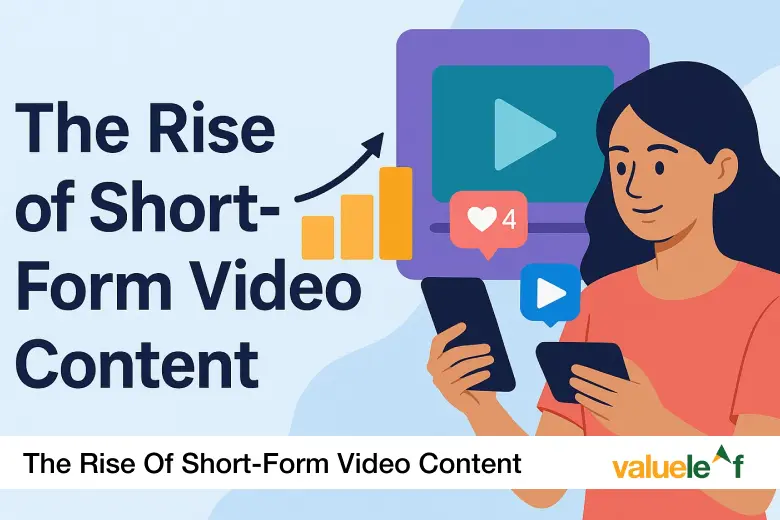Introduction
Short-form video marketing is dominating the digital landscape. From TikTok to Instagram Reels, brands are scrambling to adapt to the content format that’s capturing billions of views daily.
You’re missing out if you’re still relying solely on blogs or static posts. In this fast-paced, scroll-happy world, attention is currency, and short videos are the jackpot. So, what makes short-form video content the future of brand engagement?
What Is Short-Form Video?
Short-form video typically refers to videos under 60 seconds, often ranging between 15–60 seconds. Platforms like TikTok, Instagram Reels, YouTube Shorts, and Facebook Stories are built around this format. Unlike traditional long-form content, these videos are designed for instant consumption and maximum impact, perfect for a generation that swipes faster than it reads.
Why Short-Form Video Is Taking Over?
- Mobile-first behaviour: Over 80% of social media usage happens on smartphones, favouring bite-sized content.
- Attention economy: With average attention spans shrinking, short videos deliver more in less time.
- Algorithm love: Platforms prioritize Reels, TikToks and Shorts in feeds, boosting visibility.
- Viral potential: One 20-second clip can reach millions overnight—thanks to audio trends, hashtags, and social sharing.
Brand Benefits of Short-Form Video
Short-form video content isn’t just trendy—it’s strategic. Here’s why:
- Higher engagement rates: Videos generate 1200% more shares than text and images combined, making them the most engaging type of content on social media.
- Better ROI: With user-friendly tools like CapCut, InShot, and Canva, brands can produce high-quality videos quickly and affordably, perfect for agile marketing teams.
- Authentic storytelling: Humanize your brand through behind-the-scenes glimpses, customer testimonials, product unboxings or team highlights. This builds emotional connections and trust.
- Boosts social media engagement: Short videos often outperform other formats in terms of likes, comments and shares, especially when using trending audio and hashtags.
- Increases brand recall: Bite-sized, visually-rich content helps your message stick. Users are more likely to remember your brand when it’s presented in a fun, digestible way.
- Enhances discoverability: Algorithms on platforms like TikTok and Instagram prioritize Reels and Shorts, giving your brand organic exposure to new audiences.
- Supports cross-channel strategy: One short video can be repurposed across TikTok, Reels, YouTube Shorts, Stories, and even ads—maximizing reach with minimal effort.
- Encourages user-generated content: Short-form trends inspire customers to create and share their own videos featuring your brand, multiplying your content reach organically.
- Drives conversions: When paired with clear CTAs, short-form videos can guide viewers toward downloads, purchases, or sign-ups faster than static content.
Examples of Brands Doing It Right
|
How to Get Started with Short-Form Video
Starting with short-form video marketing may feel overwhelming—but it’s easier and more effective than you think. Whether you’re a solo marketer or a brand team, a strong foundation will set you up for success. Here’s how to dive in confidently:
- Know Your Platform
Each short-form platform has its own tone, audience, and algorithm quirks. Understanding these nuances is key:
- TikTok: Raw, relatable, trend-heavy. Best for humor, storytelling, and bold creativity.
- Instagram Reels: Aesthetic, brand-friendly, lifestyle-driven. Ideal for curated content, product showcases, and influencer collabs.
- YouTube Shorts: Value-packed, educational, and great for repurposing long-form clips. Best for tips, mini-tutorials, and behind-the-scenes.
Tip: Watch at least 10–15 trending videos on each platform to feel the vibe before you create.
Content Ideas
Creating great short-form video content starts with knowing what resonates. Here’s a breakdown of high-performing formats:
- How-to Tutorials: Teach your audience something simple, actionable, and related to your brand. Whether it’s “how to use our app in under 60 seconds” or “3 ways to style this jacket,” how-tos offer instant value and position your brand as a helpful expert.
Tip: Add text overlays and step-by-step visuals to boost clarity and shareability.
- Day-in-the-Life: Show what happens behind the scenes. A day in the life of your founder, team member, or even customer adds a human face to your brand and builds authenticity. This kind of content fosters connection and trust.
Tip: Use a relaxed tone and raw footage—people love real over perfect.
- Trends & Challenges: Jumping on trending audio or viral formats can skyrocket your reach. These videos show you’re current, relatable, and part of the conversation. Just make sure the trend aligns with your brand’s personality.
Tip: Be early—trends fade fast. Use the “Discover” or “Explore” tab on each platform to spot what’s hot.
- Product Hacks or Tips: Share clever, lesser-known uses for your product. Think of it as “insider knowledge” your audience can appreciate and apply. This not only boosts product value but sparks curiosity and shares.
Tip: Show, don’t tell. Visual hacks perform better than verbal ones.
- Quick Wins: Deliver fast, powerful takeaways your audience can use immediately—like a motivational quote, one-minute strategy, or surprising stat. These are perfect for thought leadership and positioning.
Tip: Use strong hooks in the first 3 seconds to stop the scroll.
Common Mistakes to Avoid
Even though short-form video is accessible and engaging, many brands stumble by making these avoidable mistakes:
- Over-polishing Content
Trying to make every video cinematic can actually hurt performance. Overproduced content feels less authentic and can seem out of place on platforms like TikTok or Reels, where raw and real content wins.
Fix: Embrace imperfections—focus on story, not polish.
- Ignoring Trends and Culture
Trends are the lifeblood of short-form platforms. Brands that ignore viral challenges, sounds, or meme formats often miss out on reach and relatability.
Fix: Spend time weekly on each platform’s explore tab. Jump early while trends are rising, not fading.
- Skipping Captions
Many viewers scroll with the sound off. Without captions or on-screen text, your message may be lost.
Fix: Always include auto-captions or burned-in subtitles. Tools like CapCut and MixCaptions make it easy.
- Lacking a Clear Hook
If your video doesn’t grab attention in the first 3 seconds, people scroll on. Many brands bury the value too late.
Fix: Start with an emotional trigger, bold question, or surprising stat. Hook fast, explain after.
- Failing to Track Performance
Vanity metrics like likes are nice, but real value lies in video completion rates, shares, saves, and click-throughs.
Fix: Set campaign goals and track relevant KPIs. Adjust content based on what works—not just what looks good.
- Being Inconsistent
Posting once in a while won’t help you grow. Algorithms reward consistency and audience engagement.
Fix: Create a content calendar and commit to a realistic posting schedule (e.g., 3–4 times/week).
The Future of Short-Form Video in Marketing
Short-form video is evolving rapidly—and brands that adapt will lead the charge. Here’s what to watch for:
- Social Commerce Integration: Short-form videos will increasingly feature clickable products, direct checkout options, and “Shop Now” buttons—especially on platforms like TikTok and Instagram.
Why it matters: Viewers can buy in the moment, shortening the path from attention to conversion.
- AI-Driven Personalization: AI tools are beginning to tailor short-form video recommendations based on user behaviour and interests. Soon, content will dynamically adapt to user preferences.
Why it matters: More relevance = more engagement. Brands can create micro-targeted videos for specific personas.
- Creator Collaboration at Scale: The creator economy is exploding. Influencer-led short videos offer credibility and reach that brand-only content often lacks.
Why it matters: Partnering with niche creators brings authenticity and taps into pre-built communities.
- Vertical Video as the New Norm: As mobile-first usage grows, vertical video will dominate not just social feeds, but also websites, emails, and even digital ads.
Why it matters: Brands must design for vertical by default—not as an afterthought.
- Voice & Gesture-Based Interactions: Voice commands and gesture navigation may soon become part of video content engagement, especially with AR/VR growth.
Why it matters: Short videos will go beyond views to interactive experiences.
- Advanced Analytics & Predictive Insights: Expect deeper video metrics—like sentiment analysis and predictive engagement scoring built into platforms and tools.
Why it matters: Marketers will get real-time feedback on content resonance, making optimization easier and faster.
Conclusion
Short-form video content isn’t just a trend—it’s a digital revolution. From skyrocketing engagement to increased ROI, it offers unmatched marketing potential. If your brand wants to stay relevant, build trust, and grow faster, now’s the time to lean into this format. Don’t wait. Start your short-form video marketing journey today—your audience is already watching.
FAQs
- What qualifies as short-form video content?
Short-form video content typically ranges from 15 to 60 seconds and is designed for quick consumption. Popular platforms supporting this format include TikTok, Instagram Reels, YouTube Shorts, and Facebook Stories.
- Which platforms are best for short-form video marketing?
TikTok, Instagram Reels, and YouTube Shorts are the leading platforms. TikTok excels in trends and virality, Reels works well for curated lifestyle content, and Shorts is great for educational and repurposed clips.
- Why is short-form video more effective than other formats?
It aligns with mobile-first behavior, caters to short attention spans, and receives preferential treatment in social media algorithms, resulting in higher visibility, engagement, and sharing rates.
- How often should I post short-form videos?
Consistency is key. Aim for 3–5 posts per week to maintain visibility, adapt to platform algorithms, and keep your audience engaged.
- Do I need professional equipment to start?
No. Most short-form videos are shot using smartphones and edited with apps like CapCut or Canva. Authenticity matters more than production quality.
- What types of content work best for short-form videos?
How-to tutorials, behind-the-scenes looks, trending challenges, product hacks, and motivational quick wins are top-performing formats.
- How can I make my videos stand out?
Start with a strong hook in the first 3 seconds, use captions, leverage trending sounds, and ensure your content adds value or entertains. Don’t forget a clear call to action (CTA).
- Can short-form video help with sales and conversions?
Yes. When done strategically, it can guide viewers down the funnel—from awareness to action—especially with strong CTAs and clickable product integrations.
- How do I measure the success of my videos?
Track metrics like video completion rate, shares, saves, engagement rate, click-through rate, and conversions. These KPIs provide a better picture than just likes or views.
- Is short-form video just a trend?
No—it’s a permanent fixture in the digital marketing landscape. With continued platform innovation, AI personalization and e-commerce integrations, short-form video is only gaining traction.



